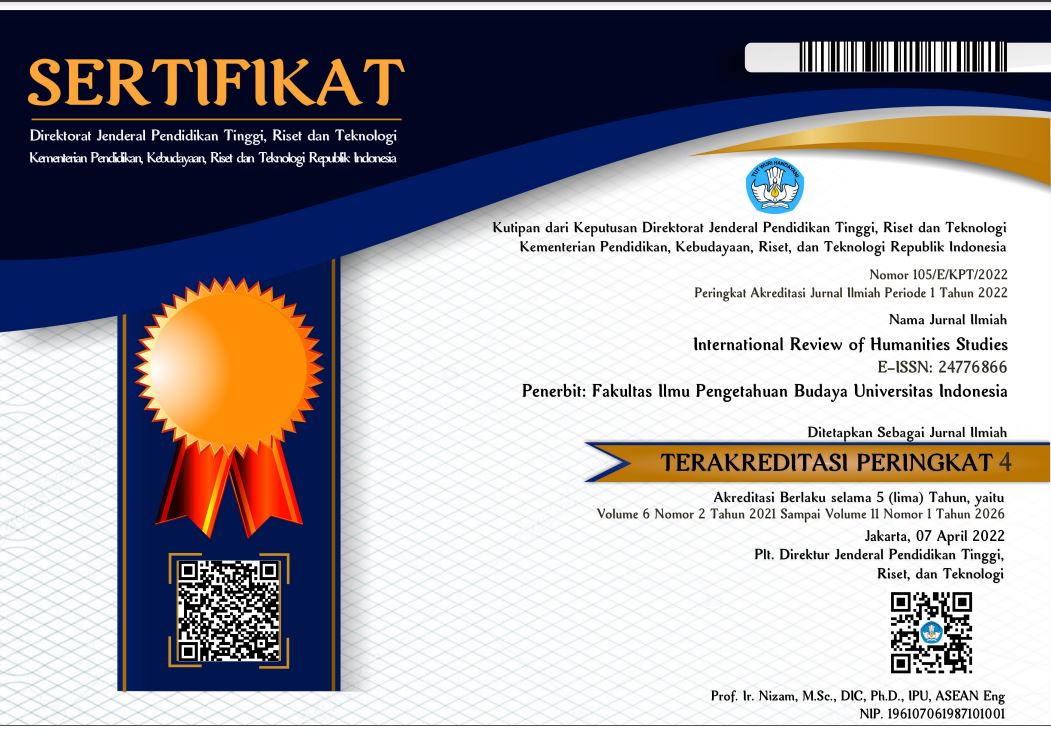International Review of Humanities Studies

Abstract
The three basic values of the philosophy of life belonging to the culture of the Sundanese people in Indonesia are the principles of triadic patterns of life contained in the Tritangtu Sunda philosophy. The three basic philosophical values contain a view of the division of triadic worlds, namely Buana Nyungcung (upper world, metaphor; sky, water, and women), Buana Larang (underworld, metaphor; earth, land, and men), and Buana Pancatengah ( Middle world, metaphor; stone, human, male and female, and life behavior). Tritangtu Sunda is a cosmic perspective of the unification of three interconnected worlds in the life of the Sundanese people. The union is the marriage between Buana Nyungcung and Buana Larang, and Buana Pancatengah which is the center of their connection. Tritangtu Sunda's philosophy of life which contains the construction of cultural and artistic values is used as a model for the directing method; Triadic Pattern Total Theater Performance. Research and concretization of method models are realized through a transformation process, to find new creations or new forms of change both in function and structure. "To transform", means to create something new that has never existed before. Transformation can mean a change in “mindset”. The research tools used Environmental theater theory and Performance Theory suggested by Schechner (1994 and 2004).
References
Ahimsa-Putra, Heddy Shri. (2001), Strukturalisme Lévi-Strauss Mitos dan Karya Sastra, Galang Press, Yogyakarta.
Anirun, Suyatna. (2002), Menjadi Sutradara, STSI Press Bandung. Studiklub Teater Bandung bekejasama dengan PUSLITMAS STSI Bandung. Brockett, Oscar. (1999). History of the Theatre.London, Allyn and Bacon Comp.
Brockett, Oscar G. (1988), The Essential Theatre, Fourth Edition, Holt, Rinehart and Winston, Inc, USA.
Ching, Francis D. K. (2007), Architecture; Form, Space, and Order, New Jersey: John Wiley & Sons, Inc.
Culler, Jonathan, (2003), Barthes, terj. Ruslani, Yogyakarta: Penerbit Jendela.
Damono, Sapardi Djoko. (2012), Alih Wahana, Edisi Revisi Pertama 2012, Editum. Djelantik, A.A.M. (2002), Estetika Sebuah Pengantar, MSPI. Bekerjasama dengan kuBuku, Bandung.
Hays, K. Michael. (1998), Architecture Theory-Since 1968, Massachusetts, USA: Colombia Book of Architecture.
Holt, Claire. (2000), Melacak Jejak Perkembangan Seni Di Indonesia. Bandung: arti.line.
Hutcheon, Linda. (2006), A Theory of Adaptation, London and New York: Routledge Taylor& Francis Group.
Isser, Wolfgang, (1978), The Act of Reading; A Theory of Aesthetic Response, London: The Johns Hopkins University Press.
Kernoddle George.R. (1967). Invitation of the Theatre, Harcourt, Brace & World, Inc, USA
K.M, Saini. (2002), Kaleidoskop Teater Indonesia. STSI Press Bandung, Lembaga Penerbitan PUSLITMAS STSI Bandung.
____________. (2000), “Teater Indonesia, Sebuah Perjalanan dalam Multikulturalisme”. Dalam Nur Sahid (ed.). Interkulturalisme dalam Teater. Yogyakata: Yayasan Untuk Indonesia (YUI).
____________ . (1988), Teater Indonesia dan Beberapa Masalahnya. Bandung: Bina Cipta.
Land, George, (1973), Grow or Die; The Unifying Principle of Transformation, New York, USA: Random House
Mitter, Shomit. (2002), Stanislavsky, Brecht, Grotowski, Brooks. Sistim Pelatihan Lakon, Terjemahan; Yudiaryani, Diterbitkan atas Kerjasama MSPI dan arti, Yogyakarta.
Murgiyanto, Sal. (2016), Pertunjukan Budaya dan Akal Sehat, Fakultas Seni Pertunjukan-Institut Kesenian Jakarta (IKJ), Kerjasama dengan SENREPITA, Yogyakarta.
Nalan, Arthur S. (2006), Teater Egaliter. Bandung. Sunan Ambu Press.
Pavis, Patrice. (1992), Theatre at the Crossroads of Culture, London: Routledge.
Rosidi, Ajip. (1966), Kesusastraan Sunda Dewasa Ini, Jatiwangi: Cupumanik.
Rusmana, Tatang. (2011), Makrokosmos Parahiangan dalam Drama Kidung Jakabandung dalam Narasi Metaforik, Strategi, dan Elanvital, Jurnal Ilmiah Seni & Budaya, Panggung, Vol.21 No.3, STSI Bandung.
Rusmana, Tatang. (2008), Kidung Jaka Bandung, Jurnal Resital, Vol. 9, No 2-Desember, ISI Yogyakarta.
Schechner, Richard. (2004), Performace Theory, London dan New York: Routledge.
_________________. (2002), Performace Studies: an Introduction, London: Routledge.
_________________. (1994), Environmental Theatre An Expanded New Edition including “Six Axioms For Environmental Theatre”, Applause, New York, London.
Suisno, Edy. (2021), Perancangan Pertunjukan Opera Minangkabau Malin Nan Kondang sebagai Alih Wahana Kaba Malin Kundang, Dance & Theatre Review, volume 4 number 1, May 2021.
Sumardjo, Jakob. (2015), Sunda Pola Rasionalitas Budaya, Kelir, Bandung.
______________. (2014), Estetika Paradoks, Kelir, Bandung.
______________. (2013), Simbol-Simbol Mitos Pantun Sunda, Kelir, Bandung.
______________. (2003), Simbol-Simbol Artefak Budaya Sunda , STSI Press, Bandung.
Suyono, Seno Joko, (2015), Tradisi dan Mitologi Kita: Dari Schechner sampai Julie Taymor, dalam Pendidikan, Birokrasi Seni dan Pergulatan Teater Timur & Barat, 80 Tahun A Kasim Achmad, Pentas Grafika: Jakarta.
Wijaya, Putu. (2004), “Teater Tanpa Lakon”, dalam Teater Payung Hitam, Persepektif Teater Modern Indonesia, Kelir, Bandung.
Yohanes, Benny. (2013), Teater Piktografik, Migrasi Estetik Putu Wijaya dan Metabahasa Layar, Cipta, Dewan Kesenian Jakarta.
Yudiaryani. (2015), WS Rendra dan Teater Mini Kata, Galang Pustaka, bekerja sama dengan Istitut Seni Indonesia (ISI) Yogyakarta.Yogyakarta.
_________. (2012), Membaca Pendidikan Seni dan Budaya Melalui Pergeseran Paradigma Seni Pertunjukan Teater. Pidato Ilmiah dalam rangka Dies Natalis ISI Yogyakarta ke XXVIII. 30 Mei 2012.
_________. (2002), Panggung Teater Dunia. Yogyakarta. Pustaka Gondho Suli.
Recommended Citation
Rusmana, Tatang
(2023)
"TRIADIC PATTERN TOTAL THEATRE AS A MODEL FOR THEATER DIRECTING METHODS BASED ON THE CONSTRUCTION OF TRIANGTU SUNDANESE PHILOSOPHICAL VALUES,"
International Review of Humanities Studies: Vol. 8:
No.
2, Article 1.
DOI: 10.7454/irhs.v8i2.1107
Available at:
https://scholarhub.ui.ac.id/irhs/vol8/iss2/1
Included in
Architecture Commons, Art and Design Commons, Audio Arts and Acoustics Commons, Education Commons, Film and Media Studies Commons, Museum Studies Commons, Social and Behavioral Sciences Commons


